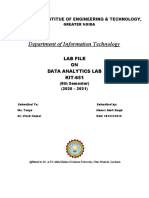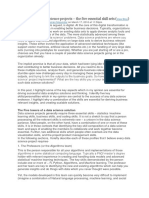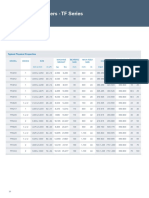Data Science With Python PDF
Uploaded by
rushi sableData Science With Python PDF
Uploaded by
rushi sableData Science with Python Certification Training
Course Agenda
Lesson 1: Data Science Overview
Data Science
Data Scientists
Examples of Data Science
Python for Data Science
Lesson 2: Data Analytics Overview
Introduction to Data Visualization
Processes in Data Science
Data Wrangling, Data Exploration, and Model Selection
Exploratory Data Analysis or EDA
Data Visualization
Plotting
Hypothesis Building and Testing
Lesson 3: Statistical Analysis and Business Applications
Introduction to Statistics
Statistical and Non-Statistical Analysis
Some Common Terms Used in Statistics
© Copyright 2015-2016, Simplilearn, All rights reserved.
Data Distribution: Central Tendency, Percentiles, Dispersion
Histogram
Bell Curve
Hypothesis Testing
Chi-Square Test
Correlation Matrix
Inferential Statistics
Lesson 4: Python: Environment Setup and Essentials
Introduction to Anaconda
Installation of Anaconda Python Distribution - For Windows, Mac OS, and Linux
Jupyter Notebook Installation
Jupyter Notebook Introduction
Variable Assignment
Basic Data Types: Integer, Float, String, None, and Boolean; Typecasting
Creating, accessing, and slicing tuples
Creating, accessing, and slicing lists
Creating, viewing, accessing, and modifying dicts
Creating and using operations on sets
Basic Operators: 'in', '+', '*'
Functions
© Copyright 2015-2016, Simplilearn, All rights reserved.
Control Flow
Lesson 5: Mathematical Computing with Python (NumPy)
NumPy Overview
Properties, Purpose, and Types of ndarray
Class and Attributes of ndarray Object
Basic Operations: Concept and Examples
Accessing Array Elements: Indexing, Slicing, Iteration, Indexing with Boolean Arrays
Copy and Views
Universal Functions (ufunc)
Shape Manipulation
Broadcasting
Linear Algebra
Lesson 6: Scientific computing with Python (Scipy)
SciPy and its Characteristics
SciPy sub-packages
SciPy sub-packages –Integration
SciPy sub-packages – Optimize
Linear Algebra
SciPy sub-packages – Statistics
SciPy sub-packages – Weave
© Copyright 2015-2016, Simplilearn, All rights reserved.
SciPy sub-packages - I O
Lesson 7: Data Manipulation with Python (Pandas)
Introduction to Pandas
Data Structures
Series
DataFrame
Missing Values
Data Operations
Data Standardization
Pandas File Read and Write Support
SQL Operation
Lesson 8: Machine Learning with Python (Scikit–Learn)
Introduction to Machine Learning
Machine Learning Approach
How Supervised and Unsupervised Learning Models Work
Scikit-Learn
Supervised Learning Models - Linear Regression
Supervised Learning Models: Logistic Regression
K Nearest Neighbors (K-NN) Model
Unsupervised Learning Models: Clustering
© Copyright 2015-2016, Simplilearn, All rights reserved.
Unsupervised Learning Models: Dimensionality Reduction
Pipeline
Model Persistence
Model Evaluation - Metric Functions
Lesson 9: Natural Language Processing with Scikit-Learn
NLP Overview
NLP Approach for Text Data
NLP Environment Setup
NLP Sentence analysis
NLP Applications
Major NLP Libraries
Scikit-Learn Approach
Scikit - Learn Approach Built - in Modules
Scikit - Learn Approach Feature Extraction
Bag of Words
Extraction Considerations
Scikit - Learn Approach Model Training
Scikit - Learn Grid Search and Multiple Parameters
Pipeline
© Copyright 2015-2016, Simplilearn, All rights reserved.
Lesson 10: Data Visualization in Python using Matplotlib
Introduction to Data Visualization
Python Libraries
Plots
Matplotlib Features:
Line Properties Plot with (x, y)
Controlling Line Patterns and Colors
Set Axis, Labels, and Legend Properties
Alpha and Annotation
Multiple Plots
Subplots
Types of Plots and Seaborn
Lesson 11: Data Science with Python Web Scraping
Web Scraping
Common Data/Page Formats on The Web
The Parser
Importance of Objects
Understanding the Tree
Searching the Tree
Navigating options
© Copyright 2015-2016, Simplilearn, All rights reserved.
Modifying the Tree
Parsing Only Part of the Document
Printing and Formatting
Encoding
Lesson 12: Python integration with Hadoop, MapReduce and Spark
Need for Integrating Python with Hadoop
Big Data Hadoop Architecture
MapReduce
Cloudera QuickStart VM Set Up
Apache Spark
Resilient Distributed Systems (RDD)
PySpark
Spark Tools
PySpark Integration with Jupyter Notebook
For information on the course, visit: http://www.simplilearn.com/big-data-and-analytics/python-for-data-science-training
© Copyright 2015-2016, Simplilearn, All rights reserved.
You might also like
- Data Science Training in Naresh I Technologies100% (3)Data Science Training in Naresh I Technologies18 pages
- 100 Data Scientist Interview Questions by DataInterview 1688929352No ratings yet100 Data Scientist Interview Questions by DataInterview 16889293527 pages
- 50+ Latest Advance Django Most Important Interview Questions Updated 2021No ratings yet50+ Latest Advance Django Most Important Interview Questions Updated 202125 pages
- Introduction To Python For Data Science - Syllabus100% (1)Introduction To Python For Data Science - Syllabus5 pages
- Data Science A Beginner S Guide 1668243666100% (1)Data Science A Beginner S Guide 166824366626 pages
- Data Science in E-Commerce - Report - WritingNo ratings yetData Science in E-Commerce - Report - Writing18 pages
- 15 Essential Python Interview Questions: Data Structures Primitive Types The Heap100% (1)15 Essential Python Interview Questions: Data Structures Primitive Types The Heap144 pages
- Machine Learning Projects For Final Year PDFNo ratings yetMachine Learning Projects For Final Year PDF4 pages
- Write Python Instead of SQL!: An Introduction To SqlalchemyNo ratings yetWrite Python Instead of SQL!: An Introduction To Sqlalchemy10 pages
- Summer Training Project in Python ProgrammingNo ratings yetSummer Training Project in Python Programming34 pages
- 2 Place Solution: Instacart Market Basket AnalysisNo ratings yet2 Place Solution: Instacart Market Basket Analysis36 pages
- Chapter 2 - Introduction To Data ScienceNo ratings yetChapter 2 - Introduction To Data Science36 pages
- ENG 202: Computers and Engineering Object Oriented Programming in PYTHONNo ratings yetENG 202: Computers and Engineering Object Oriented Programming in PYTHON56 pages
- Machine Learning Project Report - Customer SegmentationNo ratings yetMachine Learning Project Report - Customer Segmentation2 pages
- Introduction To Database Programming in PythonNo ratings yetIntroduction To Database Programming in Python26 pages
- STQA SEM III SPPU MAR APR 2023 FINAL PDF-1_removedNo ratings yetSTQA SEM III SPPU MAR APR 2023 FINAL PDF-1_removed35 pages
- Machine Learning with Python: Design and Develop Machine Learning and Deep Learning Technique using real world code examplesFrom EverandMachine Learning with Python: Design and Develop Machine Learning and Deep Learning Technique using real world code examplesNo ratings yet
- Example: Fire Design of A Protected Unrestrained HEA Section Beam Exposed To The Standard Temperature Time CurveNo ratings yetExample: Fire Design of A Protected Unrestrained HEA Section Beam Exposed To The Standard Temperature Time Curve10 pages
- Sunshine Nuvoco - Vista P.R 11026299 MCC - Panel 6 5 23No ratings yetSunshine Nuvoco - Vista P.R 11026299 MCC - Panel 6 5 234 pages
- Trio Grizzly Feeders - TF Series: Product CollectionNo ratings yetTrio Grizzly Feeders - TF Series: Product Collection2 pages
- Electrode Handling Procedure - Simple - SMAW0% (1)Electrode Handling Procedure - Simple - SMAW7 pages
- Hpcs - Healthcare Product: Comparison SystemNo ratings yetHpcs - Healthcare Product: Comparison System9 pages
- JDVP EPAS Learners Achievement MonitoringNo ratings yetJDVP EPAS Learners Achievement Monitoring14 pages
- CP837 Design & Build For The Rehabilitation of Doha South Sewerage Treatment WorksNo ratings yetCP837 Design & Build For The Rehabilitation of Doha South Sewerage Treatment Works2 pages

























































































